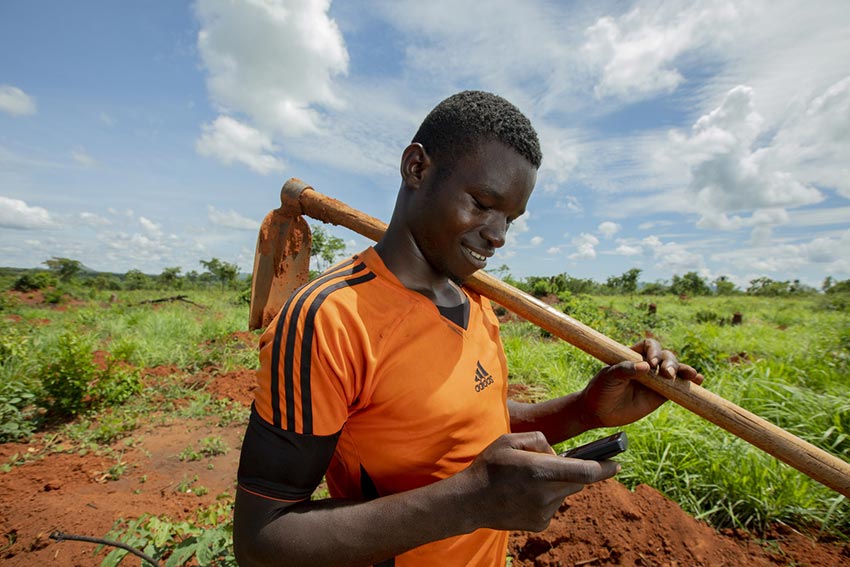
Photo Credit: Jessica Scranton/FHI 360
Digital technology offers promising ways to solve some of the world’s development challenges. At FHI 360, we are applying new and existing technologies to build resilience among the communities where we work.
What is technology for resilience?
Let’s look at what we mean by resilience. The U.S. Agency for International Development (USAID) defines it as “ the ability of people, households, communities, countries and systems to mitigate, adapt to and recover from shocks and stresses in a manner that reduces chronic vulnerability and facilitates inclusive growth.”
Recently, we’ve been using The Rockefeller Foundation’s definition: “Resilience is the capacity of individuals, communities and systems to survive, adapt and grow in the face of stress and shocks, and even transform when conditions require it.”
When we talk about technology for resilience, we are referring to digital technology – hardware or software – that builds or supports resilience capacity. People may assume resilience refers only to climate change, but it is much broader. A lot of development and humanitarian work in health, livelihoods and disaster response can be viewed through a resilience lens.
Building resilience is about collaborating with people and communities and supporting them to take control of their futures in ways that build from their existing assets. Technology can help do that more efficiently, allowing them to access information and decision-making tools they might not have had in the past.
Building resilience is about collaborating with people and supporting them to take control of their futures in ways that build from their existing assets. Technology can help do that more efficiently. Click To TweetWhat are key tenets for using technology to build resilience?
The nine Principles for Digital Development, such as design with the user in mind, is a great place to start. FHI 360 helped to shape the principles through our work with USAID’s Mobile Solutions Technical Assistance and Research (mSTAR) project. We’ve also captured tenets related to effective planning and due diligence in an Excel-based tool. We tested this tool with 19 organizations from the Democratic Republic of the Congo, Georgia, India and Nepal to ensure it met the needs of a diverse range of practitioners.
It is unlikely there will be ever a single catchall technology solution, which is why collaboration and partnerships are also important. By adopting a modular mindset, we can combine and leverage multiple technology-based services to improve resilience. The concept of a modular mindset draws from our work with the Atlas of Innovation for Economic Stability. It means layering different but complementary interventions to achieve more holistic and comprehensive development outcomes.
Could you share any examples from your experience?
FHI 360 curated the Inventory of Digital Technologies for Resilience and found more than 100 examples of digital technologies being used to enable resilience, in some capacity, in the Asia-Pacific region. The examples included a wide range of use cases, including mobile apps to allow small farmers to file insurance claims after natural disasters and wireless remote temperature sensors to track vaccine cold chains in rural health facilities. Some of these examples may fade away, but others will achieve sustained impact.
While the latest technology may be exciting, I am more interested in the sustainability model behind the technology. Planning for sustainable scale from the start is something that is often overlooked, particularly in the development sector.
How does FHI 360 leverage technology to improve resilience?
In development, we often talk about deficits. But resilience is about building capacity to take advantage of existing strengths. It’s a positive framing, with people, communities and countries taking control of how they deal with shocks and stresses.
Our approach is holistic, working from the community level to the government level. FHI 360 explores ways to integrate technology effectively into our work. In Uganda, for example, the Climate Change Adaptation and ICT (CHAI) program made use of a combination of mobile technology, weather stations and radio to deliver advisory services to more than 120,000 farmers to increase their resilience to weather-related crop loss.
Through our new social impact investing subsidiary, FHI Ventures, we are investing in promising new technology designed for social good, such as SweetSense, where low-cost sensors are being used to analyze the performance and increase the impact of water, energy and infrastructure projects around the world.
Learn more about FHI 360’s digital solutions.
